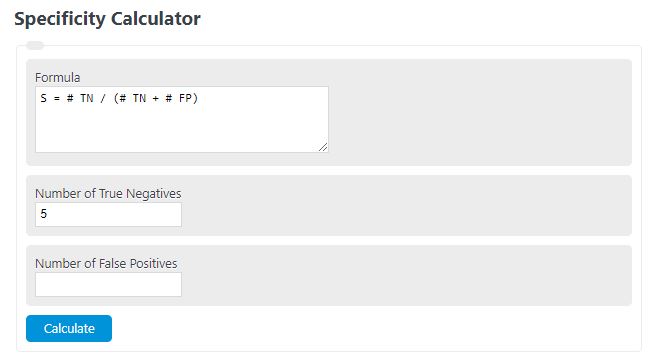Enter the total number of true negatives and the number of false positives into the calculator to determine the specificity.
- Accuracy Calculator
- Absolute Risk Reduction Calculator
- Sensitivity Analysis Calculator
- Incidence Rate Calculator
Specificity Formula
The following formula can be used to calculate specificity.
S = TN / ( TN + FP)
- Where S is the specificity
- TN is the number of true negatives
- FP is the number of false positives
Specificity (Health-Care) Definition
Specificity in health care refers to the ability of a medical test or diagnostic tool to accurately identify individuals who truly have a particular condition or disease while minimizing the likelihood of false positive results.
It measures how well a test can correctly identify those who are healthy or without the condition being tested for. Specificity is crucial in health care as it ensures patients receive appropriate and necessary care, avoiding unnecessary treatment or interventions.
When a medical test is highly specific, it means that if the test result is negative, it is highly reliable in ruling out the presence of the condition being tested for.
This is particularly important in situations where the condition being tested for has serious implications or requires immediate treatment.
For example, in the case of a specific cancer test, a high specificity would mean that if the test result is negative, the patient can be reassured that they do not have the cancer, avoiding unnecessary anxiety and further invasive investigations.
Specificity contributes to patient safety by minimizing the risk of misdiagnosis or unnecessary interventions. It ensures that patients are not exposed to potentially harmful treatments or procedures when they do not have the condition being tested for.
By reducing false positive results, specificity helps healthcare providers make more informed decisions and provide appropriate care tailored to each patient’s needs.
Specificity Example
Let’s take a look at an example of calculating specificity. Let’s assume we have a binary test. In the end, we find that the number of true negatives is 100. With that same test, we find that the number of false positives is 10. Using the formula above, we find the specificity to be 100/ (100+10) = .909 specificity.
FAQ
What is the difference between specificity and sensitivity in medical tests?
Sensitivity measures the ability of a test to correctly identify those with the disease (true positive rate), while specificity measures the ability of the test to correctly identify those without the disease (true negative rate).
Why is high specificity important in diagnostic testing?
High specificity is important because it ensures that individuals who do not have the condition are accurately identified, minimizing the risk of unnecessary worry, further testing, and interventions for those individuals.
Can a test have both high sensitivity and high specificity?
Yes, a test can have both high sensitivity and high specificity, but it is often challenging to achieve. A balance must be struck, as improving one often leads to a decrease in the other. The ideal balance depends on the condition being tested and the consequences of false positives and false negatives.
How can the specificity of a test be improved?
The specificity of a test can be improved by refining the test criteria to better distinguish between those with and without the condition, using higher quality reagents, or employing more accurate detection technologies. However, this might affect the test’s sensitivity or other aspects.

